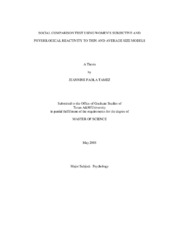| dc.description.abstract | The current study examined the subjective and physiological reactivity to body
image stimuli among females engaging in a social comparison task. Study I was
conducted to select images of thin and average size models and neutral objects for Study
II. For Study II, fifty-six female undergraduate students had their skin conductance and
startle reflex responses recorded while comparing themselves to images featuring thin
models, average size models, and neutral objects. Following the visual presentation,
participants rated every image using the Self-Assessment Manikin (SAM) rating scale.
Analysis from the SAM ratings scale revealed a significant picture type effect for
arousal, dominance, and body satisfaction, indicating that participants reported greater
arousal, more body dissatisfaction, and less control after viewing images of thin models
than after viewing images of normal models and neutral objects. With regards to the
psychophysiological data, results indicated that startle reflex responses were inhibited
during the presentation of thin models in comparison to average size models and neutral
objects. Moreover, startle reflex responses were inhibited for average size models in
comparison to neutral objects. The finding that startle reactivity to model images was
inhibited with respect to neutral images suggests pictures of models were processed affectively as pleasant, positive stimuli. The finding that startle reactivity to thin models
was inhibited with respect to average size models suggests that thin model images
elicited differentially greater positive affect than average size models. For skin
conductance, analysis revealed no significant picture type effect. Taken together, the
results of this study highlight the influence of social comparison processes on affectivity
reactivity to body image. Future research directions are discussed. | en |


